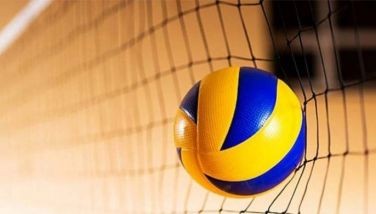Short-lived soccer mania

July 3, 2002 | 12:00am
Now that the World Cup is over, soccer is back where it doesn’t belong–at the lowest level of our sports consciousness, buried in the cobwebs of our mind. It’s not that soccer isn’t exciting because it is. It’s just that with our passion for basketball, there doesn’t seem to be any other team sport we care about.
In the pre-war era, soccer was popular in the Philippines. Believe it or not, we were competitive–at least in Asia. There were Filipino stars who shone brightly on the football field—Ygoa, Heredia, Lobregat, Ugarte, Llamas, Nieto, Bombero, Bacsal, de Guzman.
But through the years, interest in the game waned. Without a vibrant commercial league to promote soccer, collegiate players drifted to other sports after graduation or simply stopped competing. Athletes who excelled in both basketball and soccer eventually chose to specialize in hoops because that’s where the money is. You could build a career in basketball, not football. Examples of two-sport stars were Eddie Pacheco, Eddie Ocampo and Francis Arnaiz.
Today, when national tournaments are held, the top performers usually come from the military. College stars couldn’t be bothered playing–they’re either too busy working on their careers or exploring other sporting options. Curiously, Chinese clubs play in their own league and refuse to align with the Philippine Football Federation (PFF).
In the 1970s, the country saw a revival of soccer interest fueled by campus heroes like Tonio Gutierrez, the Moran brothers, Bert Honasan, Inaki Vicente, and Pepito Genato. A milestone in Philippine soccer history was marked when coach Juan Cutillas’ national squad beat Taiwan, 1-0, in the preliminary to a New York Cosmos match, featuring the legendary Pele, at the Aloha Stadium in Honolulu in 1976. Genato scored the marginal goal before 75,000 fans in the Aloha inaugurals.
When Cutillas’ glamour boys hung up their cleats in the 1980s, football lost its luster and media appeal.
But in the last 30 days, soccer mania gripped Filipino fans who momentarily forgot about basketball.
This year’s World Cup was one for the ages. It had all the trimmings of a dramatic extravaganza. The co-host compromise. The shock loss of defending champion France to Senegal in the World Cup opener. The proliferation of foreign coaches. The incredible ascension of South Korea into the semifinals–no other Asian team had ever gone as far. The unheralded US team barging into the quarters after shocking Portugal, tying South Korea, losing to Poland, and walloping Mexico. The accusations of biased officiating–who can forget Totti’s dismissal in Italy’s loss to South Korea? And of course, the reemergence of Brazil as the World Cup champion.
In Sunday’s finals, local fans packed hotel ballrooms, bars, restaurants, and even the Ayala Alabang covered basketball court to watch the game live on a giant-screen monitor. Suddenly, the most-sought-after cable TV system was Dream, which had the exclusive rights to the World Cup here. NBN-4 came to the rescue of non-Dreamers by airing the matches on a delayed, same-day basis at midnight.
So what will it take for soccer to stage a comeback on local soil?
Former Philippine Olympic Committee (POC) president Col. Julian Malonso said soccer is a game that’s perfect for Filipinos. Height isn’t might in soccer. Agility, creativity, guile, courage–these are some of the hallmarks of a good soccer player. Surely, there are more than enough Filipinos who are agile, creative, wily, and brave.
What soccer lacks in the Philippines today is a system of development from the grassroots to the schools to an exciting national league for the cream of the crop. Money doesn’t seem to be a problem for the PFF which receives a hefty dollar-denominated grant (reportedly $1 Million spread over several years) from the international governing body so if soccer isn’t able to get off the ground, the blame should be on the officials who run the sport. If money isn’t a problem, where is it being spent?
Of course, there is the traditional theory that soccer isn’t TV-friendly. Advertisers can only insert their spots on live telecasts before and after a match and at the half. That’s because no timeouts are allowed during each 45-minute half. And if the players aren’t in shape to give it their all from start to finish, the game could be a terrible bore.
Some groups are pushing soccer schools for the youth. Tomas Lozano, a former Spanish import, operates a widely-known school for kids and brings his most outstanding students to foreign competitions. But when the kids grow up, soccer becomes a thing of their past. There is no real incentive for graduates to play the sport beyond their varsity years.
Soccer derivatives like futsal play a role in kicking up interest for the sport. Coca-Cola’s go-for-gold program is another boost. But unless there is a concerted effort to create soccer heroes and role models, to establish a balanced national league, to unify the resources of each ethnic sector–Spanish mestizo, Chinese, and brown Filipino–into a common football pool, and to provide media mileage for the game, the sport will go back to sleep in the Philippines–until it awakes for the next World Cup in Germany in 2006.
In the pre-war era, soccer was popular in the Philippines. Believe it or not, we were competitive–at least in Asia. There were Filipino stars who shone brightly on the football field—Ygoa, Heredia, Lobregat, Ugarte, Llamas, Nieto, Bombero, Bacsal, de Guzman.
But through the years, interest in the game waned. Without a vibrant commercial league to promote soccer, collegiate players drifted to other sports after graduation or simply stopped competing. Athletes who excelled in both basketball and soccer eventually chose to specialize in hoops because that’s where the money is. You could build a career in basketball, not football. Examples of two-sport stars were Eddie Pacheco, Eddie Ocampo and Francis Arnaiz.
Today, when national tournaments are held, the top performers usually come from the military. College stars couldn’t be bothered playing–they’re either too busy working on their careers or exploring other sporting options. Curiously, Chinese clubs play in their own league and refuse to align with the Philippine Football Federation (PFF).
In the 1970s, the country saw a revival of soccer interest fueled by campus heroes like Tonio Gutierrez, the Moran brothers, Bert Honasan, Inaki Vicente, and Pepito Genato. A milestone in Philippine soccer history was marked when coach Juan Cutillas’ national squad beat Taiwan, 1-0, in the preliminary to a New York Cosmos match, featuring the legendary Pele, at the Aloha Stadium in Honolulu in 1976. Genato scored the marginal goal before 75,000 fans in the Aloha inaugurals.
When Cutillas’ glamour boys hung up their cleats in the 1980s, football lost its luster and media appeal.
But in the last 30 days, soccer mania gripped Filipino fans who momentarily forgot about basketball.
This year’s World Cup was one for the ages. It had all the trimmings of a dramatic extravaganza. The co-host compromise. The shock loss of defending champion France to Senegal in the World Cup opener. The proliferation of foreign coaches. The incredible ascension of South Korea into the semifinals–no other Asian team had ever gone as far. The unheralded US team barging into the quarters after shocking Portugal, tying South Korea, losing to Poland, and walloping Mexico. The accusations of biased officiating–who can forget Totti’s dismissal in Italy’s loss to South Korea? And of course, the reemergence of Brazil as the World Cup champion.
In Sunday’s finals, local fans packed hotel ballrooms, bars, restaurants, and even the Ayala Alabang covered basketball court to watch the game live on a giant-screen monitor. Suddenly, the most-sought-after cable TV system was Dream, which had the exclusive rights to the World Cup here. NBN-4 came to the rescue of non-Dreamers by airing the matches on a delayed, same-day basis at midnight.
So what will it take for soccer to stage a comeback on local soil?
Former Philippine Olympic Committee (POC) president Col. Julian Malonso said soccer is a game that’s perfect for Filipinos. Height isn’t might in soccer. Agility, creativity, guile, courage–these are some of the hallmarks of a good soccer player. Surely, there are more than enough Filipinos who are agile, creative, wily, and brave.
What soccer lacks in the Philippines today is a system of development from the grassroots to the schools to an exciting national league for the cream of the crop. Money doesn’t seem to be a problem for the PFF which receives a hefty dollar-denominated grant (reportedly $1 Million spread over several years) from the international governing body so if soccer isn’t able to get off the ground, the blame should be on the officials who run the sport. If money isn’t a problem, where is it being spent?
Of course, there is the traditional theory that soccer isn’t TV-friendly. Advertisers can only insert their spots on live telecasts before and after a match and at the half. That’s because no timeouts are allowed during each 45-minute half. And if the players aren’t in shape to give it their all from start to finish, the game could be a terrible bore.
Some groups are pushing soccer schools for the youth. Tomas Lozano, a former Spanish import, operates a widely-known school for kids and brings his most outstanding students to foreign competitions. But when the kids grow up, soccer becomes a thing of their past. There is no real incentive for graduates to play the sport beyond their varsity years.
Soccer derivatives like futsal play a role in kicking up interest for the sport. Coca-Cola’s go-for-gold program is another boost. But unless there is a concerted effort to create soccer heroes and role models, to establish a balanced national league, to unify the resources of each ethnic sector–Spanish mestizo, Chinese, and brown Filipino–into a common football pool, and to provide media mileage for the game, the sport will go back to sleep in the Philippines–until it awakes for the next World Cup in Germany in 2006.
BrandSpace Articles
<
>
- Latest
- Trending
Trending
Latest
Trending
Latest
Recommended
































